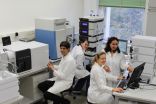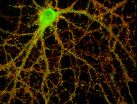Bite to the death: Sugarbag bees launch all-conquering raids
Tiny stingless bees form fighting swarms for a series of attacks on neighbours' hives
2014-10-21
(Press-News.org) They may be tiny and stingless but there's nothing sweet and innocent about a species of native Sugarbag bee when it goes to war over a coveted honey-filled hive.
A study by behavioural ecologist Dr Paul Cunningham, from QUT, and molecular biologist Dr James Hereward, from the University of Queensland, published in American Naturalist, found the bees' used their jaws as lethal weapons when they zoomed in on a neighbouring Brisbane hive to boot out the inhabitants and install their own queen to rule.
Dr Cunningham said the attacking bees arrived in a swarm and clashed jaws, locking the defenders in a "death grip" with their strong mandibles.
"Neither the attacker nor defender survives in these one-on-one death battles, during which a carpet of dead and dying bees can be seen on the ground. It is a sheer numbers game as to who wins," Dr Cunningham said.
"It took three consecutive attacks over several weeks before the hockingsi bees won out.
"When they eventually broke through the defences, they smothered the hive in a huge swarm, mercilessly ejecting the resident workers, drones and young queens. It was carnage!"
Dr Hereward said they had expected to find two colonies of the same species at war.
"The defending colony was, as we expected, Tetragonula carbonaria, but the attacking colony turned out to be a related species originating from further north, called Tetragonula hockingsi."
Dr Cunningham said the hive then settled down and there was no further fighting for several months, so they opened it up and looked at the genetics of the new brood.
"There was a new queen in residence, and she was a daughter of the attacking colony's queen."
The researchers studied more than 250 hives around Brisbane and found evidence of 46 of these all-or-nothing take-overs over five years.
"And the hockingsi bees are not always the winners," Dr Cunningham said.
"We still have many questions to answer, such as what instigates the attacks, and whether the young in the usurped hive are spared and reared as slaves, or killed outright."
Dr Cunningham said stingless bees were important pollinators and with honeybees threatened, the race was on to better understand these bees' habits of mid-air warfare and territoriality.
INFORMATION:
ELSE PRESS RELEASES FROM THIS DATE:
2014-10-21
This news release is available in German. Stroma cells are derived from connective tissue and may critically influence tumour growth. This knowledge is not new. However, bioanalyst Christopher Gerner and an interdisciplinary team from the University of Vienna and the Medical University of Vienna have developed a novel methodology for investigation. Using modern mass spectrometry, tumour-promoting activities from breast fibroblasts were directly determined from needle biopsy samples. Recently this experimental break-through is published in the renowned Journal of Proteome ...
2014-10-21
Folsom, Calif., (October 21, 2014) – A new animal study published in the Journal of Alzheimer's Disease indicates that a diet including walnuts may have a beneficial effect in reducing the risk, delaying the onset, slowing the progression of, or preventing Alzheimer's disease.
Research led by Abha Chauhan, PhD, head of the Developmental Neuroscience Laboratory at the New York State Institute for Basic Research in Developmental Disabilities (IBR), found significant improvement in learning skills, memory, reducing anxiety, and motor development in mice fed a walnut-enriched ...
2014-10-21
When it comes to the brain, "more is better" seems like an obvious assumption. But in the case of synapses, which are the connections between brain cells, too many or too few can both disrupt brain function.
Researchers from Princeton University and the University of California-San Diego (UCSD) recently found that an immune-system protein called MHCI, or major histocompatibility complex class I, moonlights in the nervous system to help regulate the number of synapses, which transmit chemical and electrical signals between neurons. The researchers report in the Journal ...
2014-10-21
Massive black holes spewing out radio-frequency-emitting particles at near-light speed can block formation of new stars in aging galaxies, a study has found.
The research provides crucial new evidence that it is these jets of "radio-frequency feedback" streaming from mature galaxies' central black holes that prevent hot free gas from cooling and collapsing into baby stars.
"When you look into the past history of the universe, you see these galaxies building stars," said Tobias Marriage, assistant professor of physics and astronomy at Johns Hopkins and co-lead author ...
2014-10-21
A new medical imaging method being developed at Rutgers University could help physicians detect cancer and other diseases earlier than before, speeding treatment and reducing the need for invasive, time-consuming biopsies.
The potentially lifesaving technique uses nanotechnology to reveal small cancerous tumors and cardiovascular lesions deep inside the body. It is showing promise in early tests by Rutgers researchers in the schools of engineering and pharmacy.
The Rutgers scientists, who published initial results of their work in the July issue of the journal Nature ...
2014-10-21
Undescended testis is commonly found in newborn boys and usually normalizes spontaneously by the age of six months. In one in a hundred boys, however, at least one testis remains undescended—a condition associated with impaired fertility and a higher risk of testicular cancer in later life. About 3500 boys are affected with this condition in Germany each year. In the currently valid medical guideline for the treatment of undescended testis, early surgery is recommended, i.e., orchidopexy before the child's first birthday, in order to prevent late sequelae. Nonetheless, ...
2014-10-21
LAWRENCE — Whiplash the Cowboy Monkey. Grumpy Cat. "Peanut," the Ugliest Dog in the World. These might be a sampling of the most familiar animals to millions of users of social networking sites like Facebook.
But one doctoral student in geography at the University of Kansas recognizes social networking sites as a potential boon for scientifically documenting Earth's biodiversity, particularly in developing nations. In fact, for this idea, Vijay Barve was just honored with a Young Researchers Award from the Global Biodiversity Information Facility, an international ...
2014-10-21
CAMBRIDGE, Mass--The boom in oil and gas produced through hydraulic fracturing, or fracking, is seen as a boon for meeting U.S. energy needs. But one byproduct of the process is millions of gallons of water that's much saltier than seawater, after leaching salts from rocks deep below the surface.
Now researchers at MIT and in Saudi Arabia say they have found an economical solution for removing the salt from this water. The new analysis appears this week in the journal Applied Energy, in a paper co-authored by MIT professor John Lienhard, postdoc Ronan McGovern, and four ...
2014-10-21
This news release is available in German. Conventional magnetic resonance imaging (MRI), well-known from its use in hospitals, can typically resolve details of up to one tenth of a millimetre, for example in cross-sectional images of the human body. Together with colleagues at the University of Leipzig, researchers of ETH Zurich are working on massively increasing the resolution of the technique, with the goal of eventually imaging at the level of single molecules – demanding an over one million times finer resolution. By detecting the signal from a single hydrogen ...
2014-10-21
(Austin, Texas) October 21, 2014 – The largest study to date of mortality trends in patients with acute respiratory distress syndrome (ARDS) shows that the rate of mortality dropped significantly over a 16-year period. Advances in critical care medicine are seen as a direct cause of the decline. The study abstract was released today in an online supplement of the of the journal CHEST and will be presented at CHEST 2014, the annual meeting of the American College of Chest Physicians in Austin, Texas held October 25-30.
Researchers at Rutgers Robert Wood Johnson Medical ...
LAST 30 PRESS RELEASES:
[Press-News.org] Bite to the death: Sugarbag bees launch all-conquering raids
Tiny stingless bees form fighting swarms for a series of attacks on neighbours' hives


